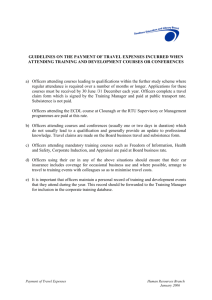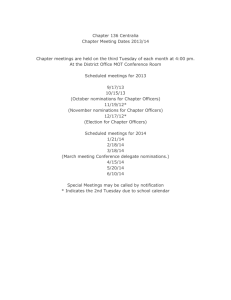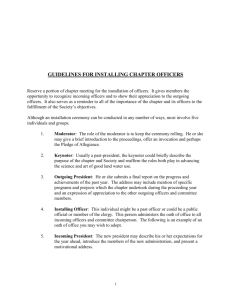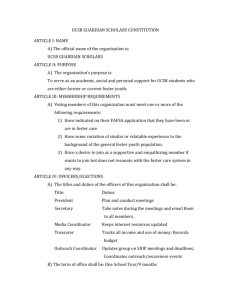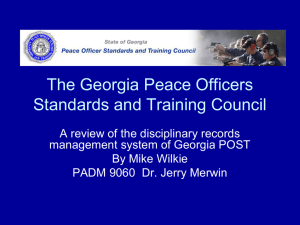Business Awareness Training
advertisement
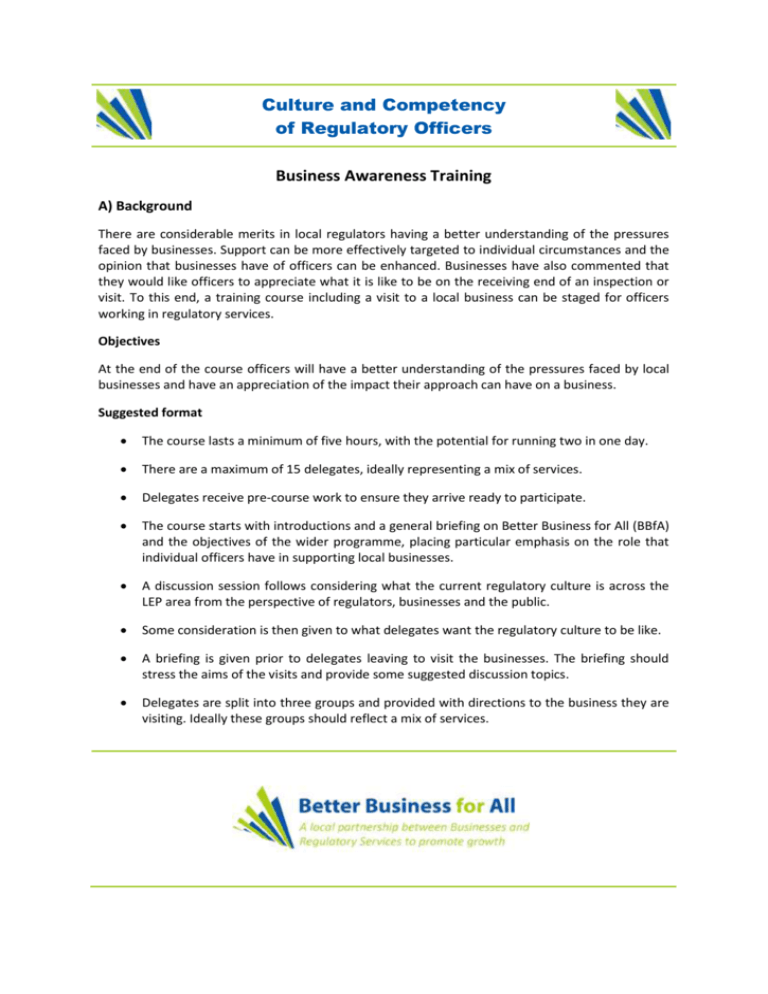
Culture and Competency of Regulatory Officers Business Awareness Training A) Background There are considerable merits in local regulators having a better understanding of the pressures faced by businesses. Support can be more effectively targeted to individual circumstances and the opinion that businesses have of officers can be enhanced. Businesses have also commented that they would like officers to appreciate what it is like to be on the receiving end of an inspection or visit. To this end, a training course including a visit to a local business can be staged for officers working in regulatory services. Objectives At the end of the course officers will have a better understanding of the pressures faced by local businesses and have an appreciation of the impact their approach can have on a business. Suggested format The course lasts a minimum of five hours, with the potential for running two in one day. There are a maximum of 15 delegates, ideally representing a mix of services. Delegates receive pre-course work to ensure they arrive ready to participate. The course starts with introductions and a general briefing on Better Business for All (BBfA) and the objectives of the wider programme, placing particular emphasis on the role that individual officers have in supporting local businesses. A discussion session follows considering what the current regulatory culture is across the LEP area from the perspective of regulators, businesses and the public. Some consideration is then given to what delegates want the regulatory culture to be like. A briefing is given prior to delegates leaving to visit the businesses. The briefing should stress the aims of the visits and provide some suggested discussion topics. Delegates are split into three groups and provided with directions to the business they are visiting. Ideally these groups should reflect a mix of services. Business Awareness Training Where possible officers should avoid visiting businesses that they could have an enforcement role in. The visits, including travel, should take a minimum of 2.5 hours. On return a working lunch could be provided. The course concludes with feedback from the visits and a discussion resulting in completion of group action plans. Once all sessions have taken place all the action plans are collated and presented to Regulatory Services Managers for action. Who to involve Business organisations will need to be involved to encourage business participation. Each business should host 3-4 officers at any one time, however some businesses may be prepared to take part in a number of courses. Officers from all regulatory partners should be encouraged to attend. Things to consider The training provides an opportunity to discuss the wider BBfA programme with operational staff. The training venue needs to be in a central location with easy access to local businesses. If officers need to travel to businesses the venue should have a car park or be on a bus route. If 2 courses are to be run on one day then the venue will need a second room. The businesses taking part are likely to be apprehensive. A detailed brief should be sent to them containing suggested discussion topics. A good range of businesses should be involved. Ideally SMEs and micro businesses as these generally have most interaction with regulatory officers. Businesses should be easily accessible from the training venue. If cars are needed to transport delegates to the business premises check prior to the day that officers are prepared to use their cars. It is important to stick to the schedule to ensure that all delegates arrive at the business premises at the expected time. Having mixed groups works well as this provides an opportunity for delegates to meet colleagues from other services. CPD certificates can be given in exchange for feedback forms. Following the sessions contact the business participants to thank them for their involvement and to receive any feedback they may have. The Action planning sheets could be used to inform the regulatory services BBfA work programme. 2 Business Awareness Training B) Detailed Agenda Programme aims To explore the current regulatory culture To put participants “in the shoes” of business to gain greater insights into their challenges and experiences of regulation To inspire culture change and leadership in the field of regulation supporting both public protection and business prosperity and growth Time Session Title 09:15 – 09:30 Welcome, introductions and aims 9:30 – 10:15 What is regulatory culture? What is our “brand”? What is “regulatory culture”? Case study discussion 10:15 – 10:30 Where are we now? 10:30 – 10:45 Introduction to visit 10:45 – 13:15 Visit – with host businesses (includes travel) 13:15 – 13:45 Feedback from the business visit (includes working lunch) 13:45 – 14:15 Brainstorming and action plans 14:15 – 14:30 Feedback and close Pre-work Participants should complete the three tasks below prior to the start of the course: 1. Review a short case study, the better regulation and culture implications of which you will consider in groups in the first session. 2. Consider the following two questions and be ready to discuss your thoughts about them: a) Consider the current ‘brand’ of regulatory services within the region and your individual authority – what would it look like to your businesses and to local people? How could you develop the brand, building on strengths and weaknesses? b) Think of one positive and one less positive example of the current regulatory culture within Regulatory Services. How would you tell the story of these examples? 3. Read the following paper outlining what is meant by the term ‘Regulatory Culture’ 3 Business Awareness Training C) Pre-course Reading What does the local regulatory system look like? The local regulatory system is complex. 433 local authorities work alongside 11 national regulators and 12 central government departments to enforce a large amount of legislation which businesses have to comply with. Regulatory services usually make up a small proportion of the local authority’s activity, for example regulatory services expenditure is around one per cent of total local government expenditure on services.1 Regulatory services have a long and proud history within local government. Local regulators can be characterised as professional and committed individuals who generally joined their profession to serve and protect the public from various threats. The reform agenda starts from a solid foundation in that the system has integrity, probity and highly committed, professional staff.2 Research indicates that over half of the interactions businesses have with their local council are through the regulatory services department3 and satisfaction levels with individual interactions with local council regulators are fairly high amongst businesses.4 However, businesses still view local regulation as a burden and have identified specific issues that relate to the culture of the regulatory system which are contributing to that burden.5 The same business is often regulated by more than one regulator within a local council (for example environmental health and trading standards)6 as well by more than one local council. Culture – What do we mean? Defining ‘culture’ is far from straightforward with multiple definitions and components of culture. Consequently, it is important that we set out a clear working definition of culture for the purposes of this session. Our working definition of culture is ‘the way we do things around here’. This covers, primarily, the regulatory interactions between local authorities and businesses. When we talk about ‘regulatory culture’ more broadly, we can think from the perspectives of the regulator, citizen and the regulated organisation. The term ‘regulatory culture’ can also encompass all the influences from the wider system, which includes national regulators, professional bodies, central government policy departments and citizens. For example, society’s attitudes towards risk will filter through and impact upon regulatory culture.7 1 2 3 4 5 6 7 For a more comprehensive view of the local regulatory system see LBRO’s mapping report, Mapping the Local Authority Regulatory Services Landscape, LBRO, November 2009 Noted in the discussion at the Regulatory Ways of Working Workshop with the LBRO Board, 9 March 2011. See Annex 2 Survey of 200 businesses for LBRO, Kirkman Associates/Telephone Surveys Feb 2009 87% agreed that they were treated fairly and 81% agreed the contact was helpful, LBRO (2010a) Business Perceptions Survey, LBRO, Birmingham LBRO (2010b) From the Business End of the Telescope: Perspectives on Local Regulation and Enforcement, LBRO, Birmingham INLOGOV (2011a) Local Authority Regulatory Interactions with Business, undertaken for LBRO by Institute of Local Government Studies [INLOGOV], University of Birmingham Risk & Regulation Advisory Council, (2009), The Risk Landscape Interactions that Shape Responses to Public Risk 4 Business Awareness Training The culture of regulators influences the tools and strategies chosen by them to achieve compliance and this in turn affects the relationship between the regulator and the regulated business.8 Ultimately, citizens benefit from the protection regulation affords them, and information about businesses which helps inform their own choices. Regulatory culture could include: Beliefs, values and assumptions mindsets, of local authority members and employees, leaders and those in businesses, as well as among organisations and actors within the wider system; attitudes and behaviours; and assumptions. Artefacts (visible structures and processes) ways of doing things, both within local authorities, businesses and national bodies; structures and teams (organisations, roles, responsibilities and what the state actually does in the regulatory context); activities (includes data, intelligence, risk and regulatory tasks); individuals (includes professional standards and competency); and approach, which might pick up issues such as co-regulation, alternatives to regulation and regulatory processes. The wider system the wider climate and authorising environment. In this business awareness session, we are focusing our work on the ‘regulatory culture’ from a business perspective. The primary focus is therefore on the culture and interaction between local authority regulators and businesses, which is set in a wider system involving national regulators, professional bodies, central government policy departments and citizens. The figure on the next page provides a simple diagram setting out the interactions that support regulatory compliance. 8 Black J. and Baldwin, R. (2010), ‘Really Responsive Risk Based Regulation’, Law and Policy, Vol 32 (2), April 2010 as cited in INLOGOV (2011b) 5 Business Awareness Training Interactions supporting regulatory compliance For our purposes, the local regulatory system encompasses the functions of environmental health, trading standards, licensing and fire safety services, in line with BRDO’s remit, that deliver regulatory outcomes for a number of policy-owners across government. Profile of regulatory services A key challenge for regulatory services is their relatively low profile both within their own organisations and nationally. By definition, regulatory services often prevent things from happening, which is inherently less visible than some other services. However, regulatory services also work in innovative ways with partners on problem solving project-based activities, for example in support of key public health outcomes around illicit tobacco, promoting safe workplaces, illegal money lending and reducing salt consumption in fast food premises. Effective political and managerial leadership, particularly promoting the best of local regulatory services, is crucially important in changing perceptions and local regulatory cultures. Some services may face difficulties in bringing their local politicians and portfolio holders around to a new way of thinking. The better regulation agenda may be perceived as a harder sell to voters and the media, so local elected members may be inclined to maintain a more enforcement-driven attitude. Understandably, there are strong concerns among members to avoid tragic and very serious incidents such as the 2005 E.coli outbreak in South Wales. Fear of local and national media coverage could also be seen to influence the regulatory culture, including public and political perceptions. 6 Business Awareness Training D) Template Letter to Participating Businesses Dear (name), Better Business for All – Business Awareness Session (date). Thank you for agreeing to take part in the Business Awareness sessions for regulators that are taking place as part of the Better Business for All programme. Better Business for All is the (LEP name) response to the Government’s priority of reducing regulatory burdens on business. The programme is aimed at removing both the real and perceived regulatory barriers to growth. Businesses have commented that many regulatory officers have little understanding of the pressures faced by small businesses and lack the appropriate communication skills needed to put a business at ease and engage effectively. The Business Awareness sessions will enable frontline officers from environmental health, licensing, trading standards and the fire service to hear directly from business the impact that their approach can have. This will help officers to adapt their approach so that they can interact more effectively with the businesses they visit and offer a more supportive service in the future. We hope that participation in these sessions will enable you to: have direct access to regulatory officers to explain the pressures that businesses face; explain to regulatory staff exactly what it feels like to be regulated; share your experiences of being regulated; influence the way local regulatory services are delivered in the future; and develop a stronger relationship and mutual understanding with local regulators. The visit: Officers will be visiting your business on (date). Prior to arrival at your premises the officers will have a workshop session discussing their current approach to business engagement and an introduction to the visit. They will finish this session at (time) and then travel to your business. I anticipate their arrival with you between (times). The visit will last up to 1.5 hours and should allow for participants to understand your business, speak to key individuals to understand the key issues in respect of regulation and the regulatory system and hear how the regulatory system could be improved to support your business. During the visit the participants will be seeking the answers to the following questions: What are the biggest business challenges that you face? How is the current economic climate affecting your business? What are your positive and less positive experiences of being regulated? What could be done to make the local regulatory system less burdensome and regulators more supportive? After the visit: On leaving your premises the officers will return to the workshop where they will give feedback on their visit and the information they have gathered. This will feed into an action plan for change. In the days that follow the visit, you will be contacted for your thoughts on how the session went. 7 Business Awareness Training These sessions promise to be a truly exciting learning experience for regulators and are providing a unique opportunity for businesses, such as yours, to help shape the future delivery of regulatory services in (area). For further information on Better Business for All visit (web address). Once again thank you for your support and I hope you enjoy the experience too! Kind regards, 8



